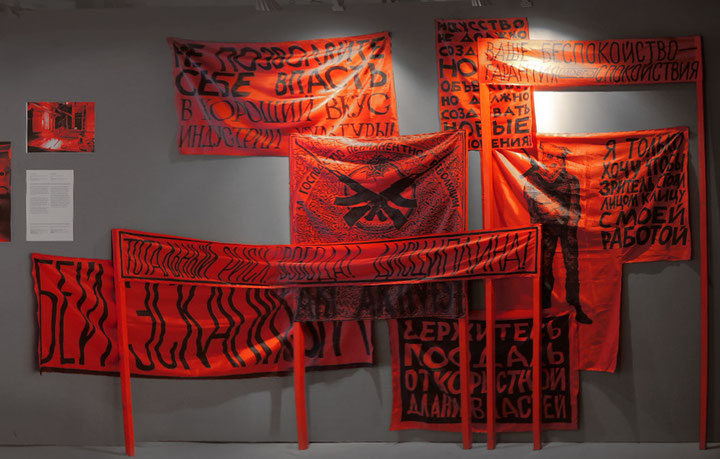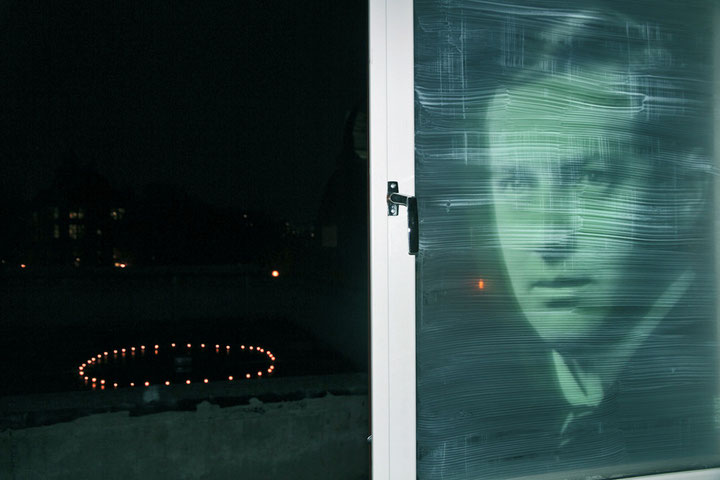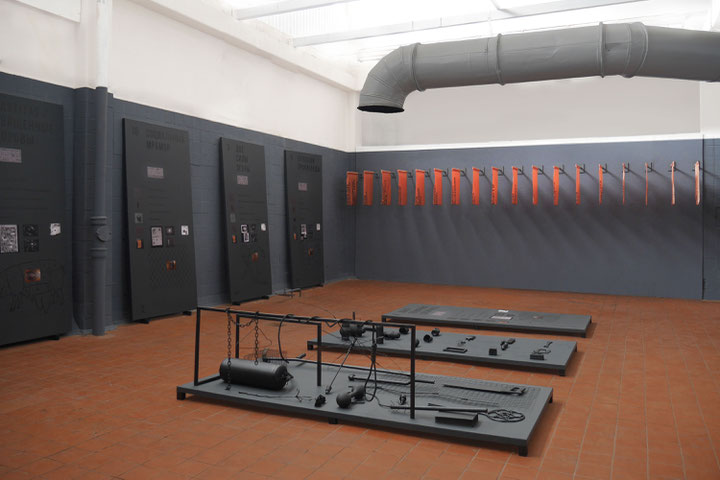Issue 2/2021 - Dinge, die uns trennen
Art doesn’t have to, but it can Change Society
About the Projects of Sergey Shabohin
“The pipes have been stinking for five years now. Rotten socialism!”
“Art doesn’t have to create new objects, it must create new relationships.”
Sergey Shabohin
Sergey Shabohin’s video art work Art Terrorism (2011) brings together a number of statements presented in the form of slogans pronounced by art terrorists in balaclavas.1 They articulate such issues and problems as the temptation emanating from the cultural industry; artists’ flirtation with authorities; skill and banality in art; the attention artists pay to the present and a critical look at the past; and, finally, contemporary art’s (self-) definition at the intersection of “unconditional love,” revolution, and the ability to bring the viewer out of a state of social apathy and what purpose that might have. All the figures in the video are dressed in red and black; they have red bandages on their left hands and are shown against a blackish red backdrop. Some of them are armed, and their threatening gestures often point at the audience. All the words are pronounced by male voices, but they are technically distorted and the speakers’ faces are hidden.2 At one point, an art terrorist in a dress applies lipstick; later, the public is addressed by a Matryoshka-doll terrorist. At the next moment, we see the doll in a terrorist’s hand talking about the connection between art and “unconditional love.” In a number of frames, the speaker’s head is hypertrophied. Once, a human figure is replaced by an open mouth visible through the balaclava, which then turns into a face and later into the figure of an armed terrorist. This five-minute video ends with a scene where one of the characters uses his rifle to write “art terrorism” on the wall (fig. w-1-4).
The video was made by Shabohin to be shown as a part of his solo exhibition scheduled for March 2011 at the Gomel Palace and Park Ensemble. However, after the explosions in the Minsk metro on April 11, 2011, the artist abandoned this idea. As you can learn from the artist’s explanation of the video concept, after the tragedy this work lost its ironic component, but this at the same time stimulated him to create “Art Aktivist,” a multimedia project that combined manifestos of art activists from different countries.
The work was shown for the first time as part of the installation “Art Terrorism (From Partisans to Activism)” in the autumn of 2011 at the Arsenal Gallery in Bialystok, within the scope of the international exhibition “The Journey to the East,” later presented at the Museum of Contemporary Art in Krakow and the Polish Institute in Kiev. The colorful balaclava has become a symbol of the “martial art of civil disobedience“3 thanks in particular to the Russian group Pussy Riot and their punk prayer “Virgin Mary, put Putin away,” held on February 19 and 21, 2012, at the Epiphany Cathedral in Elokhov and the Cathedral of Christ the Savior in Moscow. The group is known to have been officially recognized as extremist. But the balaclava image had already been used by Sergey Shabohin a year before Pussy Riot’s performance. Nadezhda Tolokonnikova met the artist in 2011 and, inspired by the aesthetics of the “Art Aktivist” portal he had launched the same year, asked him to make a logo for the emerging Pussy Riot art group (fig. w-3).
As prototypes, Shabohin used colorful balaclavas worn by political groups in the 1970s that were associated with terrorist attacks in several European countries, as well as black balaclavas that returned to the media space in the 2000s along with radical Islamic terrorism. The coincidence of the video recording (but not its public presentation) with the Minsk metro bombings, the perpetrators of which were found and executed by the authorities as terrorists—without, however, convincing the critical Belarusian society of their guilt—can manifest the overlapping of different social and political contexts, liked by the image of a colorful balaclava. It also embodied the message of one of the slogans articulated in the video: “Art doesn’t have to create new objects, it must create new relationships.”
The idea of creating new social relations and communities, as well as constructing spatial and other conditions for ensuring their existence, permeates almost all of Shabohin’s projects. In a study of contemporary Belarusian art from 2011 to 2013, shown in the form of an exhibition and later published in the monograph Zero Radius: Art Ontology of the 00s, the artist was named a key representative of the new generation of Belarusian artists (along with Marina Naprushkina and Andrei Liankevich). The combination of artistic, curatorial, critical, and editorial practices was mentioned as determinant for his work, with the latter most prominently expressed in the launch of “Art Aktivist,” an internet project on contemporary Belarusian art.4
“Art Aktivist” was actively updated for three years and today exists as an archive. In 2014, it was replaced by a new Internet project called “Kalektar,” a research platform for contemporary Belarusian art created by Sergey Shabohin in cooperation with his Belarusian colleagues the artist Sergey Kiryushchenko and the art curator and art critic Aleksei Borisionok. This platform combined older projects—namely, the Faculty of Agitation Criticism (FAC)—with some new ones, for example “Index,” a dynamic library of contemporary Belarusian art.5 During the same period, Shabohin was also engaged in his personal research projects “St()re” (since 2010) and “Practices of Subordination” (since 2011), and he also produced a number of art statements for group exhibitions in Belarus and abroad. During those years, “Ў” Gallery of Contemporary Art, opened in 2009 in the center of Minsk on the site of a public glass waste collection point, became the most important setting both for his personal art statements and the exhibition he curated.
The topics of “Art Aktivist” special projects launched in December 2011 can be viewed as one of the markers of a new understanding of contemporary art’s goals and the cultural situation the magazine was proposing. In total, three special projects were implemented dealing with the topics “Feminism in the context of contemporary Belarusian art,” “Some relevant debates on the urban space: art, architecture and political transformation,” and “No to nations! No to borders.”“6 Although the “Art Aktivist” website provides little data on the content of texts and statements collected as part of these projects, the subjects of feminism, urban space transformations, and the criticism of nationalism are supported by a large number of materials presented on the website in sections related to the above-mentioned topics. For example, the “Activism, law, censorship” section has thirty-four texts and “Gender, feminism, queer” has twenty-three. (Only the sections containing the reviews “Events, exhibitions” and “Reaction, observation, tendencies” have more texts: fifty-six and fifty-one, respectively.) These sections and special projects have one common feature—their critical attitude towards current social and political reality as described through the optics of such concepts as censorship and the norms formed by nation-states (Belarus, in particular). On the other hand, they are united by the emancipatory task of constructing new subjects and identities, primarily referring to a revision of the understanding of sexuality, urban space, and contemporary art itself.
Sergey Shabohin continued to implement the goal of social reform through art, which he had previously outlined in connection with the “Art Aktivist” launch and formulated with the help of the total installation of “Art Terrorism.” His efforts focused primarily on his two individual research projects “St()re” and “Practices of Subordination,” which have been presented in different cities and countries. These series combine readymade objects (including some the artist recreated himself), graphics, collage, and other additions and commentaries on them.
In 2015, Shabohin assembled the materials for “Practices of Subordination” he had been accumulating over the course of four years into a map (fig. w-5, see map on page 356) made of four superimposed visual-narrative layers incorporating elements from Guernica by Picasso, Homer’s Odyssey, and Ulysses by James Joyce (fig. P-1). In their turn, these were transformed into urban and architectural structures as well as human body systems such as the circulatory, reproductive, skeletal, and respiratory systems. However, the main, fourth layer of the map is formed by the submission practices themselves—primarily those the artist personally came across one way or another. The most important of them are related to phallic symbols and objects, as well as various images referring to feminine and masculine ideals, the reproductive function, and “normal” sexuality. An important role is assigned to everyday objects that symbolize the power and control the Belarusian authorities exercise—for example, a chair placed on the table as a sign of intelligence officers having visited the apartment in the absence of the hosts, or a device for attaching flags to lampposts as a collective image of the plurality of supervision and control channels (figs. w-6-1 and w-6-2). Among other important collective images, there is a visualization of Belarusian society resulting from the Google search term “social body, Belarus” and a skull at the center of the map symbolizing death and rebirth as well as the hope for political changes and a change of power in the country. Also included are images of water pipes, radio stations, and surveillance cameras in private and public spaces, standing for social ties in Belarus that not so much unite people but instead merely imitate the social cohesion so often mentioned by the authorities in relation to the Belarusian social state.
The map of “Practices of Subordination” reveals various fears and the lack of trust between people, along with cultural stagnation and the denial of the right to a future. Different forms of social exclusion, stigmatization, and pushing the citizens out of public urban spaces become evident—things that underlie Belarusian socialism at the level of power microphysics. A separate issue is the authorities’ attempt to manipulate social memory—for example, by erasing any reminders of the explosions in the Minsk metro on April 11, 2011. Returning this event to the map by indicating a space that supposedly was the epicenter of the explosion at Oktyabrskaya Metro Station, Shabohin outlines an alternative way of experiencing social and political life in Belarus—one that is, if not completely free from fears, then at least open for reflection (fig. w -6-3).
Does the map of “Practices of Subordination” with its art terrorist component offer new ground for constructing a specific alternative sociality in Belarus and for searching for its new forms? Or does it instead serve the inventory and archiving of various types of power-based control, humiliation, and submission—from everyday microphysics to forms of biopower, since we talk about Belarusian society as a social body? In this sense, Shabohin’s second series, “St()re,” where the archiving method is also used, seems to push the limits of the critical approach and offer the ground for common actions.
In that series, Shabohin affirms a new, constructivist attitude using a method that resembles Slavoj Zizek’s parallax view.7 The frame of the “St()re” series is a shop window that symbolizes nothing but consumption culture and practices. Its purpose is to “produce” objects of desire, making consumer goods as visible as possible—or even exhaustively visible. This suggests that visibility itself carries the potential for desire. However, to recall the theories of Maurice Merleau-Ponty, this potential is connected with the fact that visibility is never complete, and that it is this very incompleteness, certain sides of the object slipping from the gaze, that makes it so attractive, promising even greater completeness. But does the invisible necessarily hide within itself what the subject of desire expects? This is the point of parallax—it turns the invisible sides of the object of desire into the background needed for the perception of this object and does not necessarily harmoniously coexist with the visible sides. Thus, consumption can be turned into a clash with new meanings that are not necessarily pleasant for the viewer. Parallax also reveals various kinds of logics of the invisible existence or the transformation of the visible into it, among which, of course, there are also those related to violence. In this connection, it becomes possible to raise the issue of those subjects and practices that split the visible. Finally, parallax can promise the rehabilitation of the invisible, the restoration of its rights, which will require a change in the situation of perception.
This kind of confrontation between the visible and the invisible can be found in almost all of Sergey Shabohin’s “windows.” So far there have been nine of them already exhibited in Minsk, Gomel, Krakow, Stockholm, Bialystok, St. Petersburg, and Bishkek. The artist installed “St()re #1” in Krakow’s main market square during the Art Boom Tauron Festival in 2010. The window was attached to the sculpture Eros Bound (2003) by the Polish sculptor Igor Mitorai—a giant bandaged head with empty eye sockets, which served as its central backdrop. Online Krakow travel guides reveal that city residents are not keen on this sculpture, seeing it as lacking connection to a place so rich in historical meanings. It is precisely this lack that “St()re #1” was pointing at, for Shabohin placed objects, photographs, and reproductions in the window telling about the victims of Auschwitz, located sixty kilometers from Krakow, the Wieliczka Salt Mine, Walenty Badylyak’s self-immolation performed on the same square, and other traumatic events related to Krakow and environs. This “mournful window,” as the artist described it, prompted feedback by city-dwellers, who began to bring flowers and candles and leave messages next it, thus forming a situational community around it, as described by Boris Groys (fig. w-7).
Other “stores” worked in a similar way: The protest-related “St()re #2” on Maria Magdalena Square in Krakow, which addressed the problem of phallogocentrism in contemporary Polish culture; “St()re #7,” a spontaneous monument erected in St. Petersburg near the Black River in the memory of the Russian politician Boris Nemtsov killed at the Moskva River; and “St()re #9,” a greenhouse installed in Bishkek that raised the question of the ecological situation in the city while symbolizing civic solidarity and protest initiatives born during that period.
These and other works of the “St()re” project evoked lively—and not always positive—responses by the locals. The orientation of their protests differed, serving in some cases to maintain the status quo—for example, nuns tried to turn upside down and break up “St()re #2”—and in others to build solidarity around repressed and invisible meanings and narratives, that is, to deconstruct the “norm.” These reactions correspond to the meanings the artist himself articulated in his project and its name: “St()re” combines the words “story” and “store,” its brackets enclosing the empty space to indicate a gap existing between the visible and the invisible that needs articulation. At the same time, the aim was not only to provide a critical look at the dominant narratives but also to discover the potential for creating new ones, as well to encourage joint actions and the formation of temporary communities that relate to a specific place seen from the other side (figs. w-8 and w-10-2).
[1] Both this and other art works created by Sergey Shabohin can be found on his personal website: https://shabohin.com/Art-Terrorism.
[2] As the titles at the end of the video reveal, the roles of art terrorists were performed by Belarusian artists and art curators, including Valentina Kiselyova and Anna Chistoserdova of the “Ў Gallery of Contemporary Art,” as well as Sergey Shabohin himself.
[3] A. Tsvetkov, “Balaclava, Urinal, Rhizome. Three Books on Politically Engaged Artists,”
http://www.openspace.ru/article/511.
[4] Zero Radius: Art Ontology of the 00s, Minsk, 2000–2010, eds. O. Zhgirovskaya, O. Shparaga, R. Vashkevich (Minsk, 2013), 23.
[5 ] FAC presents “A Course of Lectures on Contemporary Art.” Index Dynamic Library brings together information (texts) on Belarusian collectors, critics, curators, artists, art duets and collectives, art managers, and art editors under sections such as “Glossary,” “Names,” “Institutions,” “Events,” “Education Sphere,” and “Gallery and Museum Business” (http://index.kalektar.org).
[6] The first project took place from December 2011 to March 2012 (with the Ukrainian feminist Tamara Zlobina invited as editor), the second from June to September 2013 (with the Lithuanian curator Ula Tornau), and the third from December 2013 to March 2014 (with Joulia Strauss, a political activist and artist from Athens).
[7] Slavoj Zizek, The Parallax View (Cambridge, MA: MIT Press, 2009).


